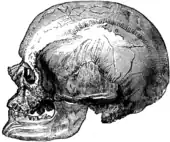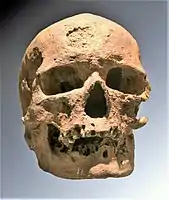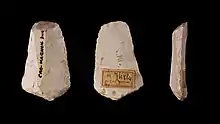克羅馬儂人
克羅馬儂人(英語:,又譯克洛曼儂人或克魯麥農人)是智人(Homo sapiens,其中包括所有現代人類)中的一支,生存於舊石器時代晚期(2~3萬年前)。原來是指發現於法國西南部克羅馬儂(法語:)石窟裡的一系列化石,現在則是指第一批在歐洲定居的早期智慧人[1]。

男性克羅馬儂人的頭顱。

克羅馬儂人的頭顱。

1868年3月,地質學家路易·拉爾泰在法國多爾多涅省莱塞济的克羅馬儂石窟裡發現了5具骨骼遺骸。其中的模式標本是一顆顱骨,被命名為「克羅馬儂1號」。這些骨骼與現代人類擁有相同特徵,包括較高的前額、直挺的姿態,以及纖細的骨架。之後在歐洲其他地區以及中東,也發現了相同特徵的標本。根據遺傳學的研究,克羅馬儂人可能源自非洲東部,經過了南亞、中亞、中東甚至北非來到了歐洲[2]。
克羅馬儂人在法國、西班牙等國留下大量史前岩畫,表示他們具有一定的藝術水準。
有歐洲人類學家認為,現在的巴斯克人是克羅馬儂人的直接後裔。
參考文獻
- First wave exemplified by: Zlatý kůň woman, Bacho Kiro, Ust’-Ishim man, Oase 1
in Prüfer, Kay; Posth, Cosimo. . Nature Ecology & Evolution. June 2021, 5 (6): 820–825. ISSN 2397-334X. PMC 8175239 . PMID 33828249. doi:10.1038/s41559-021-01443-x (英语).
. PMID 33828249. doi:10.1038/s41559-021-01443-x (英语). A female individual from Zlatý kůň, Czechia. We found that she belonged to a population that appears to have contributed genetically neither to later Europeans nor to Asians. (...) A complete genome has been produced from the ~45,000-year-old remains of Ust’-Ishim, a Siberian individual who showed no genetic continuity to later Eurasians. This contrasts with the ~40,000-year-old East Asian individual from Tianyuan whose genome is more closely related to many present-day Asians and Native Americans than to Europeans. From Europe, only the partial genome of an individual called Oase 1 and dated to ~40 ka has been recovered, and this showed no evidence of shared ancestry with later Europeans
- . Bradshaw Foundation. [2019-01-13]. (原始内容存档于2019-07-28).
This article is issued from Wikipedia. The text is licensed under Creative Commons - Attribution - Sharealike. Additional terms may apply for the media files.